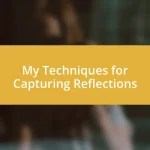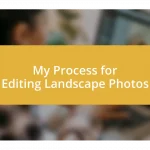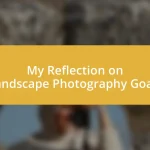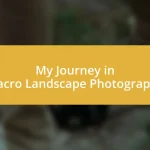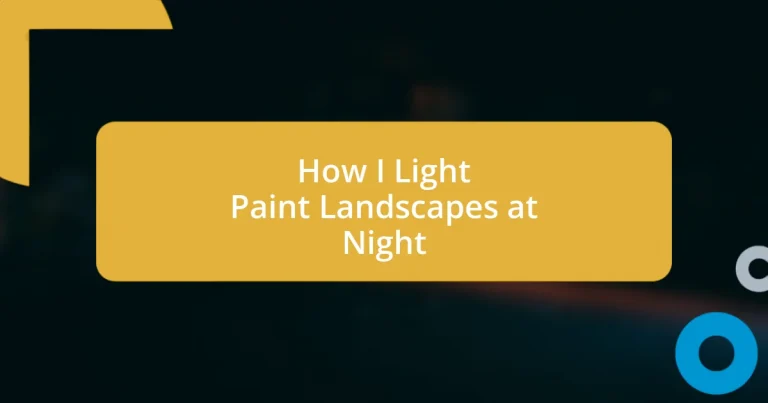Key takeaways:
- Effective light painting involves careful timing, location selection, and the use of multiple light sources to create dynamic and captivating landscapes.
- Essential equipment for night painting includes a camera capable of long exposures, a tripod for stability, and various light sources like flashlights and gel filters.
- Post-processing is crucial for enhancing night paintings, with techniques such as adjusting white balance, layering effects, and applying noise reduction to elevate the final image.
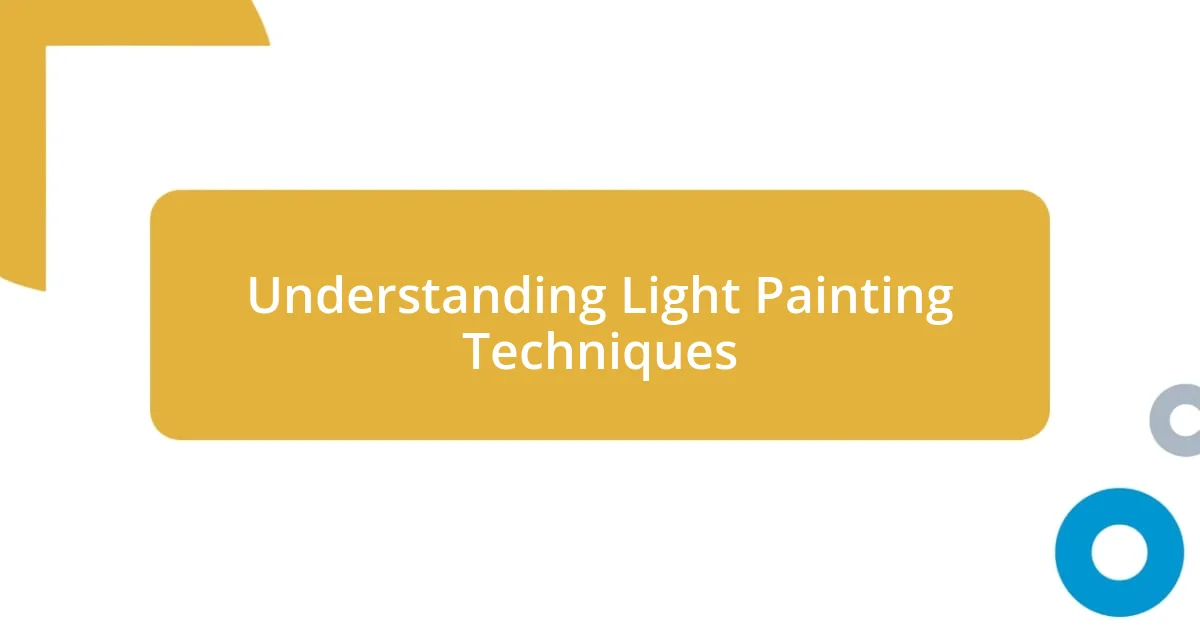
Understanding Light Painting Techniques
Light painting is about creating art through the careful manipulation of light sources. When I first dabbled in this technique, I felt a rush of excitement as I watched my mundane landscape transform into a canvas of vibrant colors and shapes. Isn’t it fascinating how something as simple as a flashlight can become a tool for artistic expression?
There are several techniques I’ve found particularly effective. One method I enjoy is using multiple light sources, which adds depth and dimension to the scene. It’s like conducting an orchestra, where each light plays its part, harmonizing to create a cohesive masterpiece. Have you tried experimenting with different colors and intensities? The way each adjustment shifts the mood of the landscape is simply captivating.
The timing is key in light painting. I’ve often spent hours waiting for the perfect moment when the ambient light is just low enough to let my light creations stand out without overwhelming the natural beauty. It’s a delicate balance; too much light can drown out what makes the night special. In those quiet moments, I feel a connection with the surroundings, as if both the landscape and I are harmonizing in the dark.
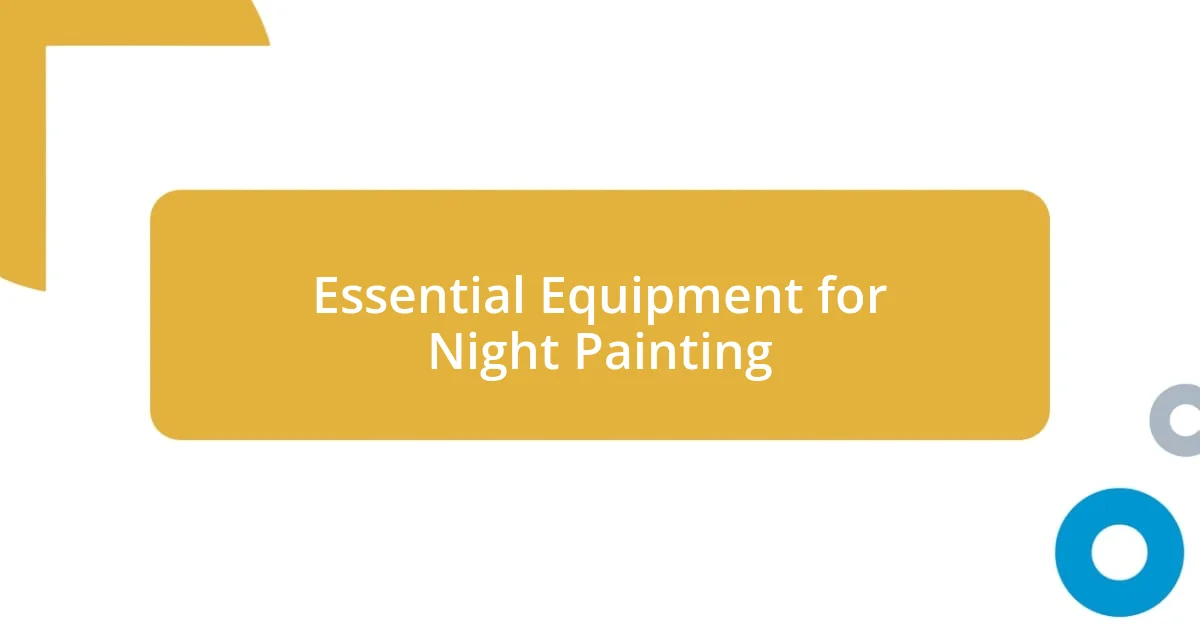
Essential Equipment for Night Painting
When it comes to light painting at night, having the right equipment can make all the difference. Over the years, I’ve discovered that certain tools are essential for producing those stunning results. For instance, I remember my first night out with just a cheap LED flashlight, realizing quickly that a more versatile gear set could open up a world of possibilities.
Here’s a list of essential equipment I recommend for anyone looking to get started:
- Camera: A DSLR or mirrorless camera capable of long exposure settings.
- Tripod: To stabilize your shots and achieve clarity in low light.
- Light sources: Multiple flashlights, glow sticks, or LED light panels in various colors.
- Filters: Colored gels to alter the light and create unique effects.
- Remote shutter release: For triggering the camera without introducing movement.
- Notebook: To jot down ideas or track settings, so you can perfect your technique over time.
My toolbox has expanded, but each of these items has played a pivotal role in my journey. Through experimentation with different light sources and colors, I’ve had nights where the scene transformed dramatically, bringing a smile to my face as I captured something truly magical.

Choosing the Right Location
When it comes to choosing the right location for light painting, the surroundings are crucial. Personally, I prefer open spaces away from city lights, which allows the stars to shine through and adds a serene backdrop to my work. I once ventured into a secluded forest, where the towering trees created dramatic silhouettes, enhancing the entire atmosphere of the scene. Have you ever found a hidden gem like that? The right location can elevate your art into something extraordinary.
A natural landscape versus an urban backdrop can significantly influence your light painting experience. In my experience, rural areas often provide a canvas of uninterrupted beauty, while urban settings can offer dynamic contrasts with architecture and artificial lights. I remember attempting a piece by a busy riverfront and being stunned at how the reflections danced on the water. Each location tells its own story, but choosing where to go will depend on your vision. Are you drawn to tranquil solitude or the vibrancy of city life?
It’s also essential to scout locations during the day to familiarize yourself with potential compositions and lighting challenges. I have often taken a day trip to see how a spot transforms from daylight to dusk and have created a mental map of where my light source will dance. Observing where shadows fall can help me visualize the final piece. It’s like laying the groundwork for a masterpiece, ensuring I’m ready when the sun sets.
| Location Type | Pros |
|---|---|
| Rural | Open spaces, natural beauty, minimal light pollution. |
| Urban | Dramatic contrasts, vibrant colors, interesting textures. |

Techniques for Effective Light Use
Effective light use in night painting requires a blend of creativity and technique. I often experiment with varying intensities and angles of light to shape my subjects; for instance, directing light from beneath can create dramatic shadows that add depth. Have you tried lighting something in a way that gives it an unexpected character? One night, while illuminating an old barn, I noticed how positioning my flashlight low transformed its weathered wood into an enigmatic figure, almost alive in the night.
Furthermore, the colors of your light sources can dramatically change the mood of your piece. I love incorporating colored gels on my flashlights to impart a warm, golden glow reminiscent of twilight, which can evoke feelings of nostalgia. Recently, while painting under the stars, I used a deep blue gel to mimic the night sky, and it truly brought my landscape to life. What emotions do you want your artwork to convey? This seemingly simple adjustment can turn a scene from ordinary to captivating.
Timing is also crucial when light painting. I’ve found that capturing a moment just before complete darkness settles can yield stunning effects. There was an instance when I painted a lakeside scene during the blue hour—where the last hints of daylight mixed with artificial light. It provided a rich canvas where the colors of my light sources blended seamlessly with the deepening sky. How often do you consider the natural progression of light in your work? Paying attention to these fleeting moments can elevate your creations significantly.

Capturing the Final Shot
When it’s time to capture the final shot, a combination of preparation and spontaneity often leads to the most rewarding results. Just the other night, I found myself at a stunning cliff edge, my camera set up, heart racing with anticipation. As I pressed the shutter, I couldn’t help but feel a rush of excitement—the pulse of the moment was palpable. Have you ever felt that storm of emotions when everything seems perfectly aligned for a single shot?
What I’ve learned through countless sessions is the importance of patience. I recall one chilly evening where I was photographing a mountain range, waiting for the clouds to part just enough to reveal a sliver of the glowing moon. That stillness provided the perfect backdrop for my light painting. The sky transformed from a dull gray to a breathtaking canvas of blues and purples. It’s moments like these that remind me: being willing to wait can often yield the most magical outcomes.
Finally, don’t underestimate the power of post-capture adjustments. After I snapped what I thought was a perfect shot, I spent time experimenting with slight enhancements in editing software. One instance stands out—adding a touch more contrast to emphasize the light trails made all the difference. Have you ever explored the world of editing after capturing a raw moment? It can be a game-changer in bringing your vision fully to life and enhances the emotion you want to convey in your artwork.
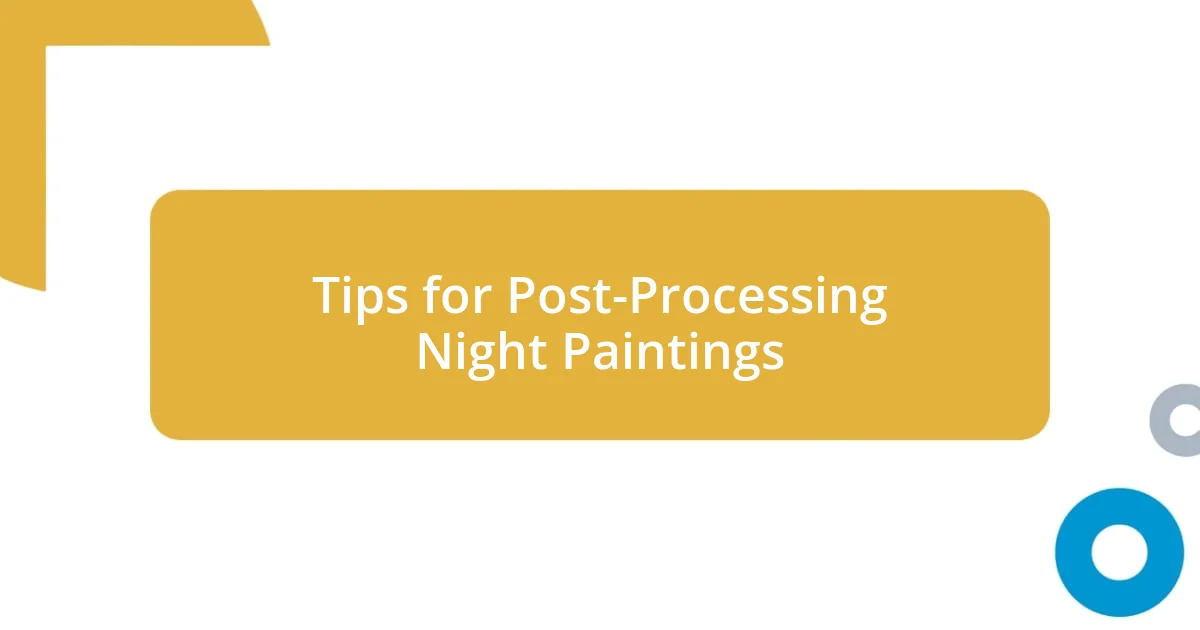
Tips for Post-Processing Night Paintings
You know, post-processing night paintings offers a whole new realm to enhance the emotions and narratives captured in your work. For instance, I’ve discovered that tweaking the white balance in my photos can bring forth unexpected moods. When I revisit some landscapes, adjusting the temperature even slightly can shift the scene from serene coolness to a cozy warmth that resonates deeper with viewers. Have you played with these settings? Sometimes, a small change can evoke a powerful emotional response.
Another vital aspect is layering. I often duplicate my original shot in software and apply different effects to each layer, allowing me to blend multiple versions until I achieve something uniquely captivating. On one occasion, I was working on a nighttime forest scene, and by adding ethereal glows to certain areas while preserving the darker shadows, I crafted a dreamlike quality that took the piece to a new level. Honestly, it’s like painting with digital brushes—what worlds can you create with this technique?
Lastly, don’t forget about noise reduction. Night scenes can sometimes capture unwanted grain, which can distract from the overall beauty. I remember the first time I noticed the grain ruining an otherwise stunning image of a city skyline—talk about frustrating! Learning to use software tools to smooth that noise while retaining details became a game-changer for me. I still find it exhilarating to see how a bit of fine-tuning can transform the final output. What have you found effective in polishing your night paintings? Your unique touch can truly make those images shine.



